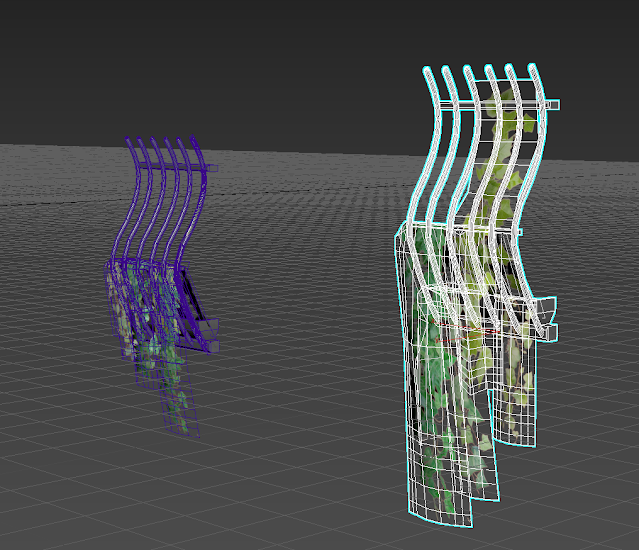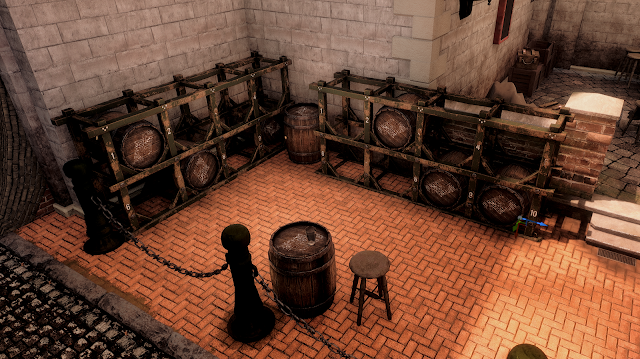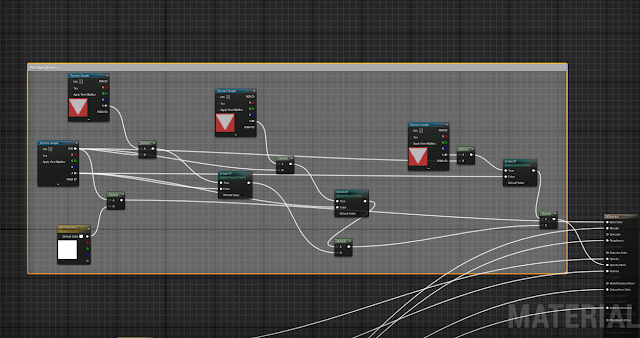Door intractability:
I decided to add some additional intractability to my level, I decided to have a door you could open to enter a shop.
Although the shop isn't textured inside or out, I wanted to make sure that it was plausible before continuing to model the rest of the assets to go inside said shop.
 |
| Door and frame created in 3ds max as 2 separate objects |
I made this doorframe to fit between the pre-existing walls of my level, so I created it to be 600cm compared to my other walls which were 300 respectively.
This is the shop front imported into the blueprint as 2 separate objects with the door pivot in the correct place to open.
On the event graph this phase is to create the door animation to open and close (Note the extra node on the end, which was used to remove the debug line tracing when a certain key input was pressed)
This section was the 'get name function' where I was able to input a name/phrase into the blueprint class name and correlate this with the widget which displayed text on screen.
 |
| Visualisation of the 'get name' on the blueprint class |
.png) |
| This graph was to smooth out the animation, initially being either open or closed, this helped the door smoothly open. Additional problems popped up like the door only opening, but by adding a 'flip flop' function to the blueprint helped the door open and close respectively. |
First person for the door:
This part of the first person graph acted as a 'get name' function for the first person character view - which correlates with the 'e to interact' name function of the door blueprint.
The first person intractability graph looked like this - where it shows the line trace feature. Within the world space, the line trace acts as a gauge to tell how far the player is from the object before they can select a key to interact. Furthermore, when the line trace is within range it will 'get name' - then followed by the set function, which will set the given name for the naming function within the door blueprint.
This is the text widget block that I used to generate the on screen 'HUD' for the player to view.
 |
| Result |
Emissive static switch parameter:
For the different lighting scenarios, I was given feedback to do with interior and emissives for the parallax effect.
It was noted that it seems unusual to have lights on during the day, so I compiled the exterior lamp post lights into separate folders, keeping them apart from the daytime light scenario.
Additionally, I went ahead and made a static switch parameter for all my interior emissives, making them on or off. The parameter was named, 'Is Day?' - so when the box is checked to true, the emissives dim or switch off completely and when unticked, they revert to their original state.
 |
| Evening with emissives, lamp posts and interior lights activated |
 |
| Day with emissives, lamp posts and interior lights de-activated |
 |
| Static switch parameter connected to the base colour and lerped between a darker value meaning 'off' - and the false connected to the remaining emissive. |
Both interior offset variations (Note the static switch parameter being on or off depending on the time of day)
Historic research:
I have collated some research for foodstuffs from the time period.
It was very difficult pinpointing the exact date for most of the items, this list is also by no means extensive and I will continue adding to it.
However, I am fairly confident that most of the items I have gathered are floating around this area of Victorian and Edwardian Britain.
There were some older antiques I managed to find, however, after reverse image searching and looking at auction sites, a lot of them were misleading. Some of the items were in fact from the 1930s and 40s, meaning that it was out of the time period I was aiming for.
Shopfront texturing:
In the past, I always used to put the entire mesh of a building inside of substance painter to texture, which isn't the best way to texture, knowing this, I went ahead and made 3 texture sheets for the shop front.
1 for a decal atlas, 1 for the door and another for the shop itself.
All of these consisted of textures I had taken for my photo library. After my recent visit to abbey pumping station, I took pictures of painted green wooden planks, I then put these into substance sampler to create a texture.
 |
| Green painted wooden panelling from primary research texture gathering |
 |
| Result after tweaking inside of substance sampler |
I then took this and exported the result into substance painter, I proceeded to make a material ID in photoshop which I could then tile the needed textures on to.
 |
| Shop material ID |
 |
| Finalised shop textures (Base colour) |
Foliage:
One thing that was mentioned I should try, that is crucial for main-line environment artists is foliage. It didn't have to be anything large scale, just something to help the overall scene and showcase my skill as an environment artist.
Here is the hanging basket I ended up making.
My mum always used to do pansies in a hanging basket, So I went ahead and made something similar.
Here are the 2 decal atlases I used for the process, both at 512. One consisted of the leaves and stems, the other of the main flower.
I used the background in colours I hadn't got on the other pieces, such as red for the leaf background and green for the flower background and use this as an ID mask to mask out the background in painter on the opacity channel.
By overlaying planes on these sections, I was able to build up these layers inside the basket I made.
I made this trim sheet inside of substance painter for the hanging basket, consisting of various sections with opacity which I could use a plane on top of. Furthermore, for more intractability, I am going to make the foliage move via a simple grass wind in the unreal material.
I recently went out for a meal, it was quite windy and the hanging baskets were moving, I believe it would be really nice to make them move via a level sequencer along with my other moving objects like the bunting.
Material Breakup:
I went ahead and started to add texture to the level.
Some feedback I got was, even though the materials were good, I needed to create some material breakup - initially, I wanted to see if I could do this in engine, preferably with some sort of 'world space ambient occlusion' where I could utilise an ambient occlusion between 2 meshes to add dirt buildup, however, I couldn't find a material function that would work suitably enough for this scenario.
Instead, I opted for a decal atlas.
This is the material ID I made in photoshop - the green represents the dirt part of the atlas, whereas the red represents opacity.
Here is an example in the level with the applied material, as well as the dirt decal atlas. After analysing dirt build up in real life and via reference images, it would be in crevasses, as well as between objects (which proved my 'world space ambient occlusion' method was not annul)
The most important part of the material was this section - I included 3 material parameters: - Hue shift (Dictates the colour of the decal)
- Material lighten (Dictates how light the decal is)
- Material Darken (Dictates how dark the decal is)
My philosophy behind these vector parameters were so I could colour match the decal to the material behind it, or alternatively, affect the colour in a more artistic way. For example, I could make the colour even darker than the base atlas if the decals were in shadow.The most important part about the material was the Opacity Intensity - I multiplied the base alpha value with a constant parameter, I did this so the base alpha wouldn't override and would make the entire material visible. I could also control the opacity to make the underlying material somewhat visible, meaning I didn't have to use a deffered decal to show the underlying normals and AO, in turn, making this method more efficient.
Painting research:
I wanted to fill out some of the interior space, to do this I created an atlas for some paintings to hang inside the visible interiors.
I looked up some 'British Victorian paintings' and this is the selection I made - additionally, I added a tiling frame across the top to utilise as much texture space as possible.
From Left to right:
- (The outlier painting - The heard of the Empire - Niels Moeller Lund, 1904)
- Landscape painting - John Constable (1776-1837)
- Equestrian Fox Hunt - Robert Stone (1820 - 1870)
- Countryside painting - J.M.W Turner (1775-1851)
- Football - Thomas George Webster (1800-1886)
 |
| Modelled painting examples, including frames |
Level texturing:
As part of the progress of the level, I wanted to document my use of texture making.
To make my levels look believable, I used Substance Sampler to capture textures, most of these were captured directly on campus.
One of the main examples being the white brick texture I used for the bottom of the buildings
Here is an example of the level where I have used the white brick texture, I also included the Absolute World Position dirt technique I used on the omnibus to create more material breakup. Here is the photo reference I gathered on campus of the Hawthorn Building, where I captured the texture I used for the level.
Here is another example of Crosswise brick paving that I captures in Loughborough - When taking these reference images, I capture them in a square aspect ratio as to reflect the actual texture size, I also get the photo as aligned as possible in order to make the tiling, alignment process easier, furthermore, it makes the sampler process for texture creation simpler.
 |
| Texture aligned and tiled inside Substance Sampler |
One issue I come across when doing this texture method is the tiling needs to be slightly greater and I find that the tiling function is pretty hit and miss in sampler. So I take the exported textures and put them inside of Substance Designer, where I add a 'make it tile patch' to each texture and then re-export the textures as this gives me a lot more control over the material than Sampler does.
 |
| Texture tiling in Substance Designer |


















































.png)
.png)
.png)

.png)
.png)
.png)
.png)

























